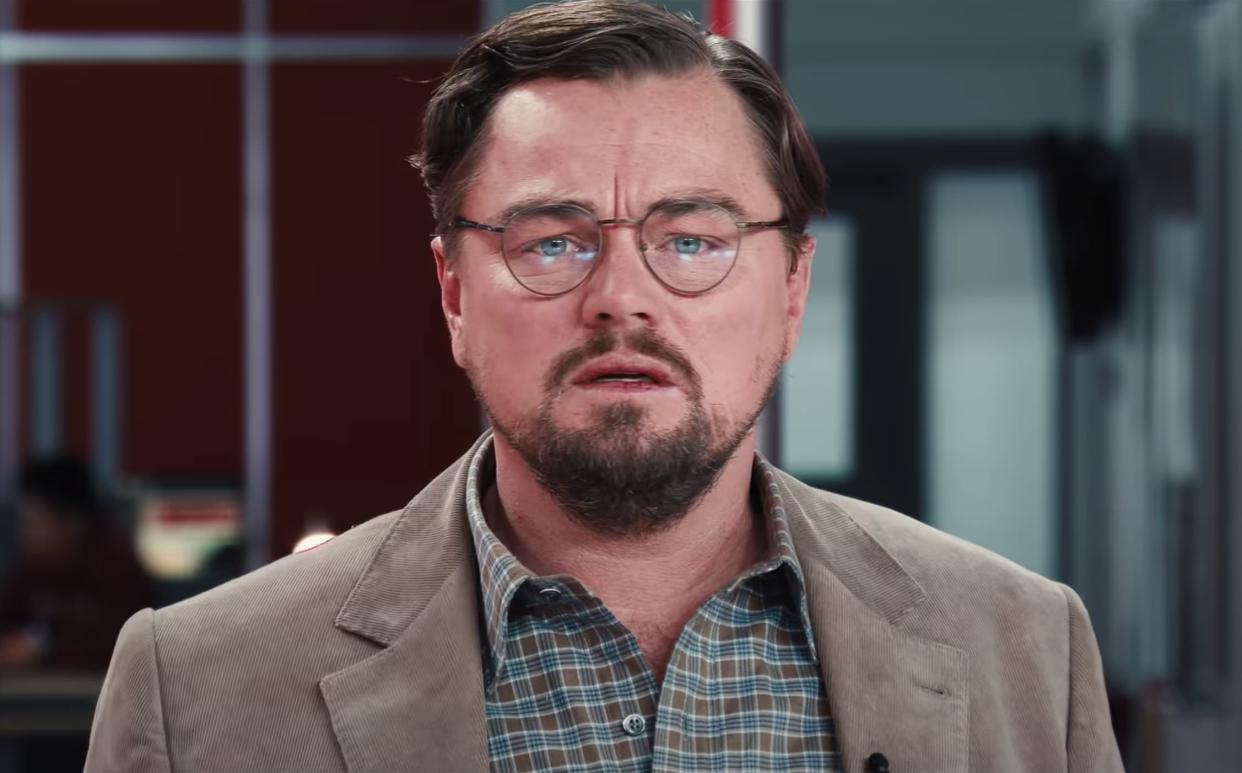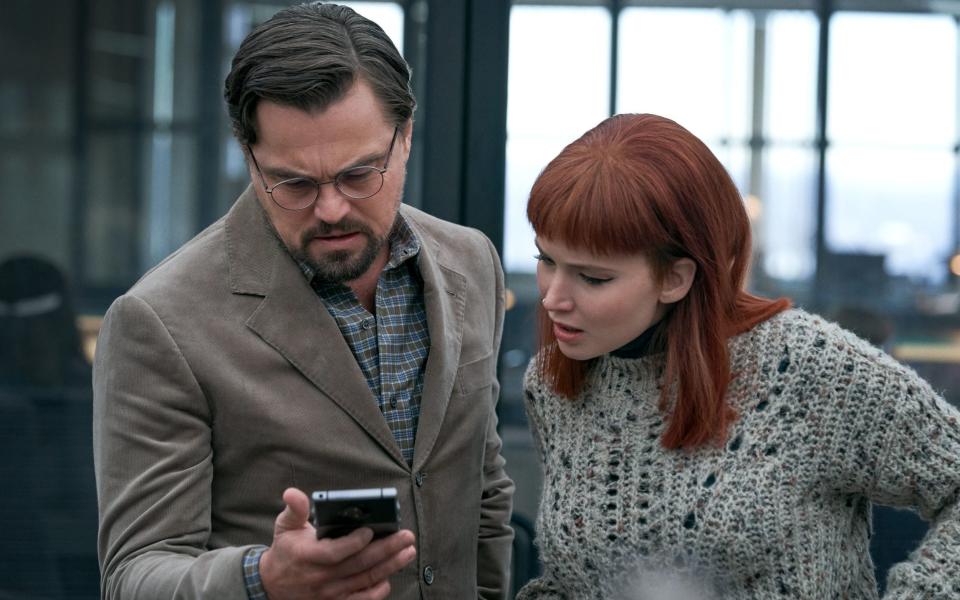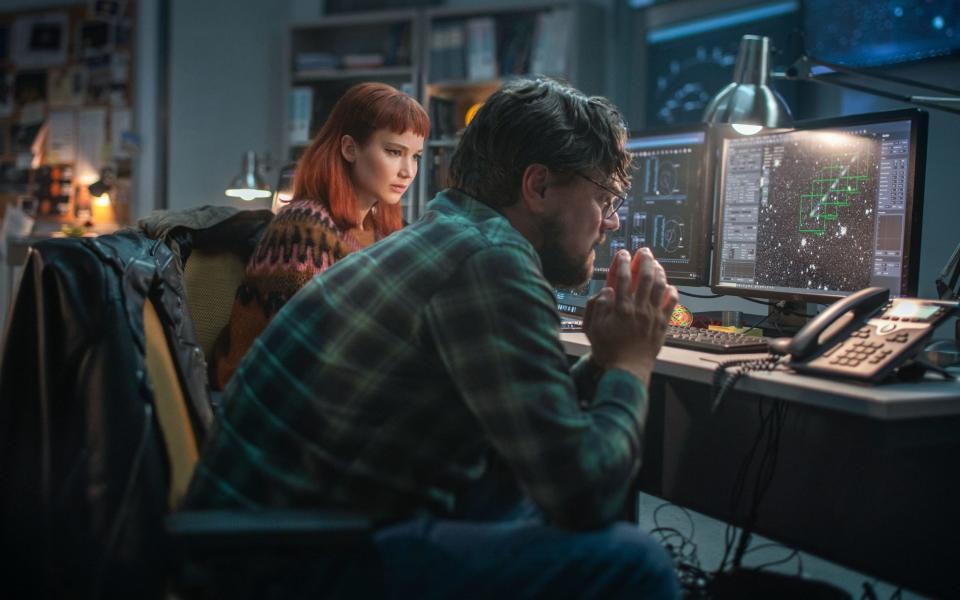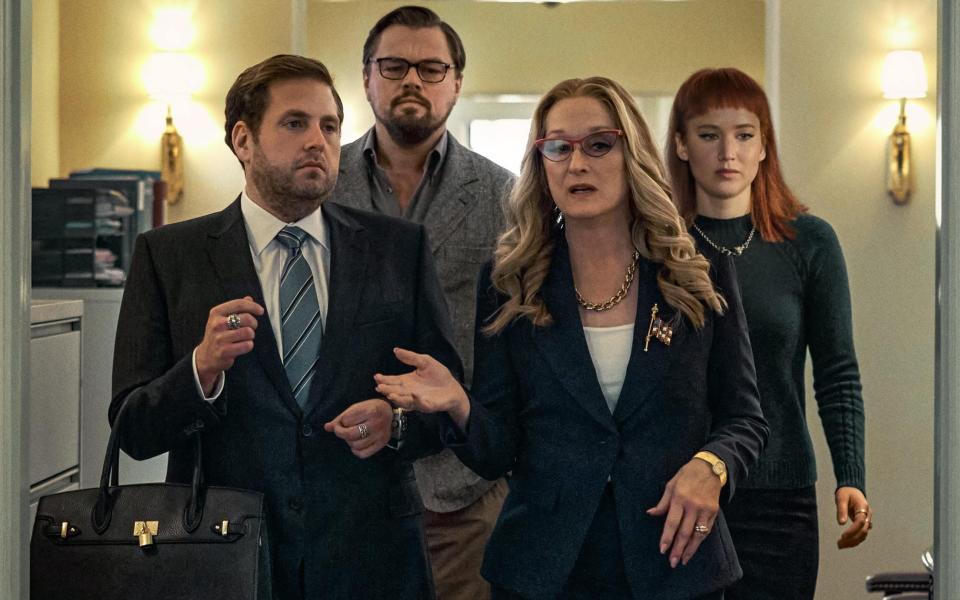Don’t Look Up: Nasa’s verdict on the Leonardo DiCaprio comet apocalypse

- Oops!Something went wrong.Please try again later.
- Oops!Something went wrong.Please try again later.
Few of us are likely to be around to see Earth’s fiery destruction by a giant rock from outer space. Dr Amy Mainzer, however, has been at pains to make sure we get a good view of it.
In Don’t Look Up, the entertaining and star-studded new film from Anchorman and The Big Short director Adam McKay, astronomers Dr Randall Mindy (Leonardo DiCaprio) and his PhD candidate Kate Dibiasky (Jennifer Lawrence) discover that a new comet is speeding towards Earth. With six months until impact and certain extinction, they scramble to get the message out.
Mainzer, astronomer and professor of planetary science at University of Arizona, and principal investigator of Nasa's Near-Earth Object Wide-field Infrared Survey Explorer (Neowise) mission, served as scientific adviser on the film, and her involvement goes all the way back to McKay’s first ideas.
“We had a lot of great conversations just about science denialism and the rejection of science in our society,” Mainzer says. “And so it was immediately clear to me from talking to him that he really wanted to tackle this very fundamental and very serious problem. That was a big motivating factor for wanting to work with him.”
After that, Mainzer acted as a sounding board for McKay, the cast and the production team in VFX, sound and costumes on all of the science. McKay, who also wrote the screenplay, was particularly involved. “I think Adam at this point is about halfway to his PhD in orbital dynamics. And Jennifer Lawrence, and certainly Leo DiCaprio – they learned a lot about it over the course of making the movie.”
It’s not all tsunamis, earthquakes and imminent extinction. She hopes, too, that Don’t Look Up, which also stars Ariana Grande, Meryl Streep, Jonah Hill and Mark Rylance, captures “just a small smidgen of the joy of science, of the fun parts of it – you know, the thrill of discovery, the excitement of getting to share something new that you learned with, with a bunch of your friends and your teammates. That's really important to science.”
But just how accurate is the science in Don’t Look Up?
Six months to live? Pretty generous for a comet
McKay originally wanted Earth to be threatened by a gigantic asteroid. Mainzer talked him down to a nine-kilometer comet from the Oort Cloud, a theorised belt of icy bodies at the very edge of the Solar System.
“Even a comet that is nine kilometers [across] is gonna cause a huge amount of damage,” she says. “If it's a lot larger than that, then you might not even have a story, right? Because people would just throw up their hands immediately.”
Comet Dibiasky is modelled on Comet Neowise, which Dr Mainzer’s team discovered in March 2020 – even the first pictures Dibiasky pulls up of her comet “are pretty much some of the discovery images of Comet Neowise”.
In the film, Earth has a little over six months to destroy the comet, which, it turns out, is actually a leisurely timeframe.
“That object we found in late March, and it did make its closest approach to the sun by early July,” says Dr Mainzer. “These things really can move very fast with respect to the Earth just because of their orbits.”

Huge objects can be discovered en route to us with only a few months’ notice. Fortunately, though, there’s no need to panic.
“The good news is, space is so huge that it's really unlikely that such a large object and the Earth would ever be at the same place at the same time. But, that said, it kind of fit the plot of the movie.”
We really would be flattened by world-rolling tsunamis
Quite apart from the comet’s immediate impact, DiCaprio’s Dr Mindy warns of mile-high tsunamis destroying population centers around the world, and cataclysmic climate-change mopping up any survivors. A fairly miserable weekend all round, then.
None of that is exaggerated for cinematic effect. It’s all based on what we’ve gleaned about the effects of the asteroid which wiped out the dinosaurs 65 million years ago from the fossil record and the 93-mile wide Chicxulub crater left in the Gulf of Mexico by the impact.
“Because we can look at the fossil record, we know that sudden climate-change as a result of releasing all the greenhouse gasses that occurred when all these forests lit on fire, because of the debris, we know that that wiped out a big fraction of life on Earth. Anything larger than about, say, 75 pounds, just went extinct.”

The maths works out
In the opening few minutes of Don’t Look Up, Dr Mindy and his students crack open some beers and kick together a rough trajectory for Comet Dibiasky on a whiteboard. It’s not just filler either – Mainzer ran the numbers on the orbital maths to make sure it was all accurate.
“What you see is some of the formulas for a very classical method of determining an asteroid or comet’s orbit. The idea is basically just to iteratively solve for where it’s going to go. You make an initial guess, and then you refine it, and you do it again and again and again.
“Now, normally, we really would use a computer because it’s a lot faster. But in this case, Dr Mindy is using it as a teachable moment.”
Scientists are a laugh, actually…
The high spirits on show in that scene – before the realisation that the world could conceivably end very soon – are another thing Dr Mainzer felt it important to include.
“There’s kind of the stereotype that you sit by yourself in a cave somewhere, and calculate something really boring for a long time. I mean, you can certainly do that if you want. But in my experience, science is a team-effort process.”
The film gets something extremely important to the scientific process right, too. The first shot of Don’t Look Up is of Lawrence’s Dibiasky making a cup of tea and some toast.
“I can definitely vouch for that. And the importance of snacks. That’s a big thing for scientists, especially if you go to graduate school. Snacks are important. We take that very seriously. We’re very food-motivated.”

…but they do get lost in science-speak
In her work with DiCaprio, Mainzer says she had “a lot of great conversations” about the ways scientists try to communicate their ideas in public, as well as the tensions between science’s inherent uncertainty and the clear “take-homes” a civilian might expect.
“We talked a lot about some of the catchphrases we might inadvertently say, like ‘the importance of taking things to first principles’, ‘the importance of the peer review process’.”
Mainzer and McKay’s earliest conversations kept coming back to that same problem.
“We don’t necessarily learn in school how to communicate to the general public. And yet it’s really important, because what good is it if we learn all this stuff and then don’t tell anybody?”
Big coats are essential
One of Mainzer’s pointers to the costume department was that all scientists at the mountaintop observatory needed to be kitted out with parkas. She learned the hard way that they’re essential astronomy gear. On one visit to a high-altitude observatory in Chile she packed her parka in her checked luggage, which promptly went missing.
“I froze like crazy. I had to buy a sweatshirt at the airport gift-shop, and it was a miserable, miserable experience. So the parka is very realistic. Small, but very important.”
Yes, there is an actual Planetary Defence Officer
Rob Morgan’s Dr ‘Teddy’ Oglethorpe, who tries to get Dr Mindy and Kate’s discovery taken seriously by the powers that be, is Nasa’s Planetary Defence Officer, knitting together the scientific community and the government and putting together plans to keep Earth safe from threats in space.
It’s a real job. Nasa’s real Planetary Defence Officer is Lindley Johnson, with whom Mainzer has worked for years. He’s “a great advocate for making sure that we actually do have a plan for asteroid and comet impacts,” she says.
“Lindley has done a lot to make sure that we have the tools that we need, to be able to do the good basic astronomy to find out where the objects are.”

…but not all the science is rock-solid…
Naturally, the film takes some liberties. “It's definitely set in a timeframe that's just slightly more technologically advanced than we are today,” says Mainzer.
A plan to destroy the comet with drones comes together particularly quickly. “I talked to Adam about this, and we realised that five years of design reviews probably wouldn’t make for the most exciting movie.
“So the timeline’s a little bit compressed – you don’t sit through millions of WebEx calls, some of which drop out, going over the quality-assurance reviews that we would normally do when we build the spacecraft. We did gloss over that part a little bit.”
…especially the bit about the comet on a collision course with Earth
“I don’t think this is much of a spoiler, but we don’t know of any comet that’s heading directly here – full stop,” says Mainzer. “So that's the great news.”
Don't Look Up is in cinemas and on Netflix now

